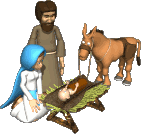


Christmas Trees and Decorations

Christmas tree in a Danish home, 2004.
The declaration ceremony begins with the hymn Jumala ompi linnamme (a translation of Martin Luther's Ein` feste Burg ist unser Gott) and continues as the Declaration of Christmas Peace is read from a parchment.
Decorations
In the Western world, rolls of paper with secular or religious Christmas motifs are manufactured for the purpose of wrapping gifts. Common motifs include Christmas trees, holly, poinsettias, mistletoe, swags, wreaths, Santa Claus, the Nativity, angels, carolers, nutcrackers, toy soldiers, sleighs, sleds, drums, drummer boys, bows, reindeer, Christmas tree ornaments, gingerbread people and gingerbread houses, candies, stars, snowflakes, snowmen, snow babies, and penguins.
Christmas trees may be decorated with lights and ornaments. The interior of a home may be decorated with garlands and evergreen foliage, particularly holly and mistletoe. In Australia, North and South America and to a lesser extent Europe, it is traditional to decorate the outside of houses with lights and sometimes with illuminated sleighs, snowmen, and other Christmas figures.
Since the 19th century, the poinsettia has been associated with Christmas. Other popular holiday plants include holly, mistletoe, red amaryllis, and Christmas cactus.
Municipalities often sponsor decorations as well. Christmas banners may be hung from street lights and Christmas trees placed in the town square. In the U.S., decorations once commonly included religious themes. This practice has led to many lawsuits, as some say it amounts to the government endorsing a religion. In 1984, the US Supreme Court ruled that a city-owned Christmas display, even one with a Nativity scene, does not violate the First Amendment.
Although Christmas decorations, such as a tree, are considered secular in many parts of the world, the Kingdom of Saudi Arabia bans such displays as symbols of Christianity.
Social aspects and entertainment
In many countries, businesses, schools, and communities have Christmas parties and dances in the weeks before Christmas. Christmas pageants may include a retelling of the story of the birth of Christ. Groups may visit neighborhood homes to sing Christmas carols. Others do volunteer work or hold fundraising drives for charities.
On Christmas Day or Christmas Eve, a special meal of Christmas dishes is usually served. In some regions, particularly in Eastern Europe, these family feasts are preceded by a period of fasting. Candy and treats are also part of Christmas celebration in many countries.
Many people also send Christmas cards to their friends and family members. Many cards are also produced with messages such as "season's greetings" or "happy holidays", so as to including senders and recipients who may not celebrate Christmas .
Because of the focus on celebration, friends, and family, people who lead more isolated lives, or who have recently suffered losses, are more likely to suffer from depression during Christmas. This increases the demand for counseling services. It is widely believed that suicides and murders spike during the holiday season. However, the peak months for suicide are May and June. Because of holiday celebrations involving alcohol, drunk driving-related fatalities increase.
NEXT: The Culture of Christmas
|
|
|
|
|
|
|
|

|
|
|



|
|
|
|
|
|
|
|

|
|
|